
Even though the Olympics are over, there is still time to see Go for Gold!; photographs by Gesche Würfel at Civilian Art Projects in DC. From the essay by Al Miner, assistant curator at the Hirshhorn, Würfel’s two series on view Go for Gold! and Farewell from the Garden Paradise “deliver visual eulogies for East London’s Lower Lea Valley. With the eye of a trained urban planner and the lyrical lens of her camera, Würfel examines dormant spaces caught between a residential past and a grand future as sites for the 2012 Summer Olympic Games…. Gesche Würfel’s work tells not of the competition between athletes, but rather between urban generations and, indirectly, between cities that vie for the wealth and power of hosting the Olympics.” The exhibition is on vie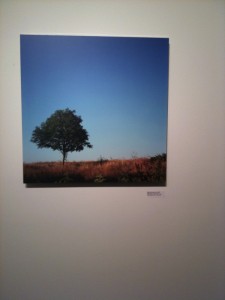 w until March 20, 2010.
w until March 20, 2010.
Go for Gold!
February 19-March 20, 2010
Civilian Art Projects
1019 7th Street, NW
Washington, DC
202.607.3804
Hours: Wednesday & Saturday 1-6pm, Friday 4-8pm
Director: Jayme McLellan
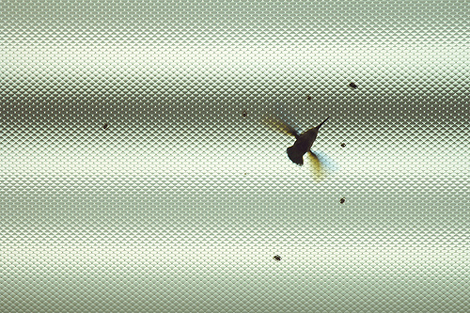
Hummingbird, from "100 Ways..." ©Kate MacDonnell
Kate MacDonnell is inspired by literature, poetry, music, and family in her often diaristic photographic work. “100 ways to kneel and kiss the ground,” the title of her ongoing series, is borrowed from a poem by the 13th century Persian poet, Rumi. MacDonnell finds wonder in the everyday. She meditates on the moments that make the common not so common–a hummingbird against the backdrop of a fluorescent office light; blue sky with a parhelion phenomenon. Her photographs rarely include people, but she sees the arrangement of personal space as a portrait of a person. MacDonnell highlights the particular while at the same time referencing the commonality in the individual and in doing so speaks to a larger shared existence.
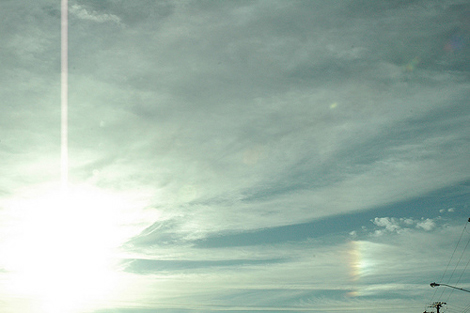
Fire Rainbow and Flare, from "100 Ways..." ©Kate MacDonnell
Larissa Leclair: How did you get into photography?
Kate MacDonnell: I started in Painting and Drawing at the Corcoran. In my third year, I was frustrated with painting. I had the impulse to paint and to record little moments that I saw in the world, but wasn’t really attached to any subject. It was the act of looking that I was interested in doing. I spent a lot of time in the library and gathered books to take back to my studio to have a lot of visual resources to work with. I was doing paintings from death portraits and from other photographs. I came across William Eggleston’s Guide and was like, “Oh, I could take pictures!” In high school I had done black-and-white photography and my teacher had graduated from the Corcoran and was able to convince the photo department that I didn’t need to take the black-and-white classes and that I just needed to get into a color class. I ended up staying in the Fine Art Department, the Photography Department was separate, and just did color photography before there was much crossover between the two departments. I got to maintain my studio space that I had as a painter and hang all my color prints that I was working on. It was a beautiful situation.
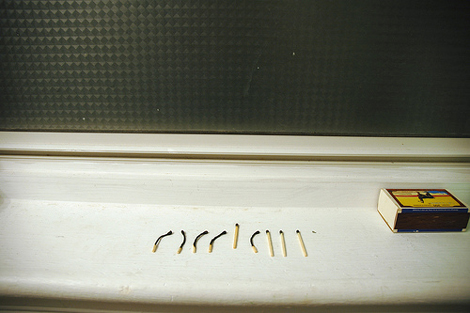
Zach's Menorah, from "100 Ways..." ©Kate MacDonnell
LL: Are you still shooting color film and printing traditional c-prints?
KM: No, I do all digital now, but I consider going back.
LL: Did you begin your series “100 ways to kneel and kiss the ground” at the Corcoran? Tell me about that body of work.
KM: “100 ways” is post-Corcoran. I see myself doing a marathon–one thing morphs into another. I don’t know when it started. It is all digital and I started doing digital work in 2004. So I guess that would be a rough start date. David Lynch uses transcendental meditation as a source for creativity. He uses meditation every day and gets to a subconscious plane that we are all on and then uses that to create something. What I am doing is not that. I am thinking about that in a different way entirely. I am looking at the world for those things, those bits of visual evidence of ideas–that are relatable on a deeper subconscious level–and gathering bits of that. The creative part is in the editing–putting these disparate little moments together that hopefully resonate with anyone viewing the images.
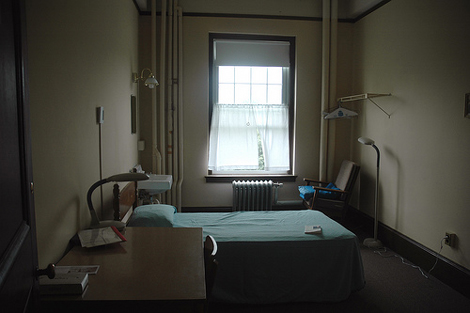
Weston, Campion Center, from "100 Ways..." ©Kate MacDonnell
LL: Your work is very meditative and poetic and I do see those little moments–personal spaces, personal arrangements, and personal things–which speak to a universal commonness. Let’s talk about the titles of your photographs–they are very specific. There is a lot more that you can read into the image when you take into account the title.
KM: I didn’t title my images for a long time. That was the idea: the communication is the image itself, to have that direct relationship with the image without being told some other little piece of information. I liked the directness of it. But then titling work, especially when things are more abstract, acknowledges your connection with the image that you’ve made, and it can help convey the image to the viewer in that they see there is some sincerity to it, some other way in. Language is another way to help it be more accessible. I want the images to be accessible. I don’t want to shut the viewer off.
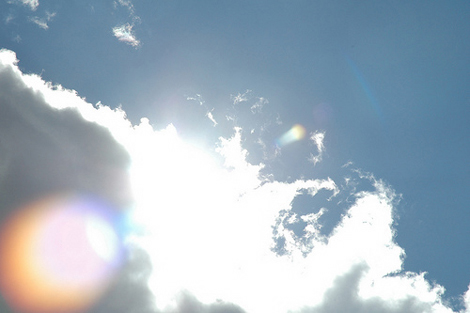
Sky Cartography for Common's Father, from "100 Ways..." ©Kate MacDonnell
LL: Can you explain the title “Sky Cartography for Common’s Father?“
KM: Do you know the rapper Common Sense? His father is a poet, Lonnie Lynn. He is always on Common’s records doing spoken work. Poetry and literature are very important to my work. It could be Milan Kundera; it could be Rumi; it could be Lonnie Lynn. I’m interested in the human thread. So the album is “Be.” Lonnie Lynn does a spoken word piece on the last track and he can’t say the word cartography. He says, “Be a car … topographer,” and then laughs a bit, “Be a maker of maps … ” He owns the way he just goes right over it. It’s awesome. He also says, “Be the author of your own horoscope.” I like that too. The image reminded me of a crude map of the U.S. and I thought about this poem and the kids that are all saying what they want to be at the beginning of it. And I thought that I would want to be a maker of maps, but of the sky.
LL: I also see a spiritual and metaphysical dimension to your work. Is that a conscious decision?
KM: [It is] as conscious as the spiritual or metaphysical is in my life, in my interaction with the world.
LL: Which it is.
KM: Yeah definitely. That’s there.
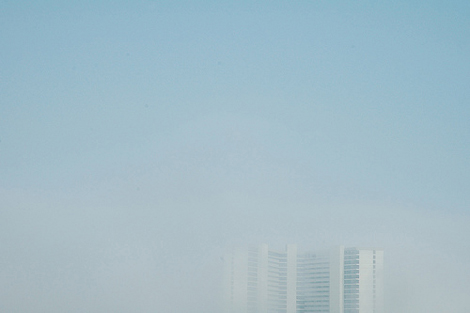
The Fountainhead, Ocean City, MD, from "100 Ways..." ©Kate MacDonnell
LL: Are there 100 images in “100 ways to kneel and kiss the ground?”
KM: No, and on purpose, 100 is not what Rumi meant. What Rumi means is there are infinite ways. The body of work has an infinite number of images that can be added to it in the future, or images that I already made, in a “negative notebook” somewhere that might be part of it but that I just don’t have in the series yet.
LL: You are represented by Civilian Art Projects (DC). How did you come to work with Jayme McLellan? And what role does working with such an influential curator have on you as an artist?
KM: Jayme is amazing. She is like a force of nature. I have great respect for what she is doing and has done for the DC art scene. She gets work that might not be as commercially viable in this town out there and on view to challenge us in DC as viewers. I met her when I was in a group show that Colby Caldwell curated at DCAC back in 2001. She was working there at the time. Fastforward several years to when Jayme had gotten a (semi) permanent space in DC for Civilian Art Projects which, in the first several months of its existence had been utilizing alternative spaces, collaborating with other galleries, etc in order for Jayme to show work that she cared about and wanted to get on view. Jayme invited me to be represented sometime in late 2007 after the gallery had landed at the 7th and D location. And I had my first solo show at Civilian Art Projects in spring of 2008. Jayme is great to work with because it doesn’t feel like work. She allows for me to have my own autonomy, but has an understanding of my work and a photographer’s eye and an analytical yet idiosyncratic mind. I trust her editing and sequencing and was really pleased with the 17 images that she curated into the show from the 100+ that she had seen. The ideas and major themes of the body of work were accentuated through her edit. What makes her such a joy to work with is that she allows for true collaboration. For example when our opinions on the layout of the show differed, Jayme listened to my rationale and accommodated my concerns while keeping her vision for the show clear and concise. I was really pleased with the show.
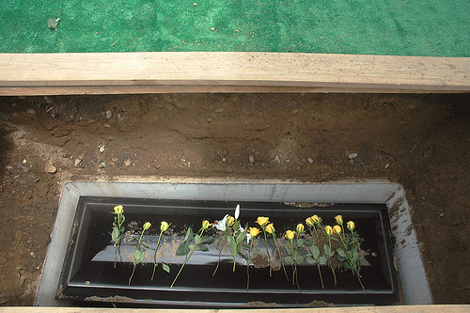
Joe's Grave, from "100 Ways..." ©Kate MacDonnell
LL: Your work would do well in book format.
KM: I have done a couple of self-published books. There are a million companies out there. I have done Blurb, Snapfish, Lulu, ibook. I’ve done a bunch. They are functional, a great way to work out editing and sequencing. To me they are a taste but not very satisfying. The not satisfying part is the print quality. For instance, for the 100 ways show, I worked with Soung Wiser of DC’s General Design Company and Jayme to create a book that would go along with the show. Jayme, Soung and I all worked together to edit and sequence the images. Soung worked on the layout within the confines of the Blurb software at the time. Now both the layout options 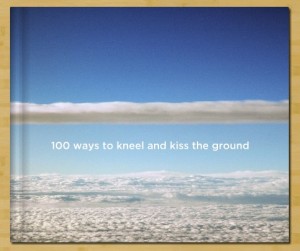 and the paper quality have improved, but at the time the quality of the paper and printing didn’t warrant the price of production. But, yeah, I love photo books as a medium. It is such a nice intimate way to view a collection of images. I would love to have a nicely published short-run trade edition eventually.
and the paper quality have improved, but at the time the quality of the paper and printing didn’t warrant the price of production. But, yeah, I love photo books as a medium. It is such a nice intimate way to view a collection of images. I would love to have a nicely published short-run trade edition eventually.
LL: As an artist, why choose Washington, D.C.?
KM: It’s home. I’ve never lived anywhere else. I grew up right outside of D.C. and came to school in D.C. and then just stayed here. We have this idea or ideal in the U.S. that you should move around and I’ve kind of had the impulse now and then but I also like the idea to be close to where I am from. I have family in the area. I like having deep roots.
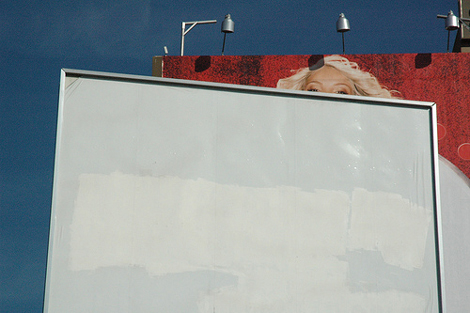
Blank, from "100 Ways..." ©Kate MacDonnell
LL: Do you photograph every day?
KM: Yeah, pretty much. I carry the camera with me, street photographer style.
LL: How was it photographing every day for “SAMETIME 7:15”?
KM: That was really awesome. It was a fun project to work on. As much of a pain as it was to have to commit every Sunday night to uploading and captioning the images, it was always fun to see on Monday what had come together from everyone. As a photographer doing a solitary pursuit, it is nice to have that feeling of connection with other people in the community on a daily basis. It is rare that that’s the situation, and daily for a year. That connection is really bolstering to the creative process. Michael Lease, one of the artists that started the SAMETIME project, insists on community.
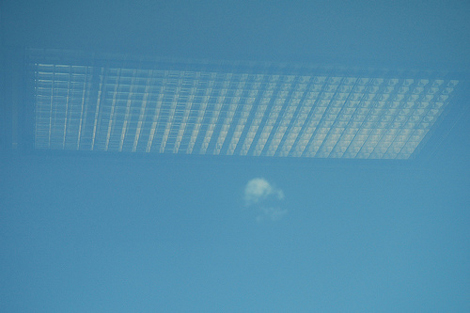
Reflection and Cloud, from "100 Ways..." ©Kate MacDonnell
LL: When you write about your own work you mention the new topographics movement, which coincidentally the original exhibition has been restaged at LACMA [Los Angeles County Museum of Art]. How are those photographers–Robert Adams, Lewis Baltz, etc.–influential to you?
KM: They were part of my impetus to do photography. I was born in 1975 when that show happened. I was born into the world that they were making images of. I was born into one of those cookie-cutter houses, in a cookie-cutter community. Here they are from the outside saying, “This is house, house, house, house.” They were speaking to these places being devoid of aesthetic value because they were these manufactured environments–man’s imposition on the landscape. But I am like, “Well, no, because I live inside it, and this house faces this way and that one faces the woods. It is the same box but it faces the woods. Their stairs face that way and on their stairs they have a fake tree.” There are lives being lived here. Growing up in that environment was a bit surreal but the similarity was comforting. It was like a David Lynch type normalcy. Every house is the same, but the stuff in it is different and its orientation to the street shifts. It is interesting to see how people treat the same thing differently and make it their own. I’m interested in these little intricate details. Along with wanting to make images that denote the humanity of these places, I was keenly drawn to their seemingly simplistic but in fact, very subtle and sometimes sublime use of composition. I like the feeling of looking at images that are like still waters.
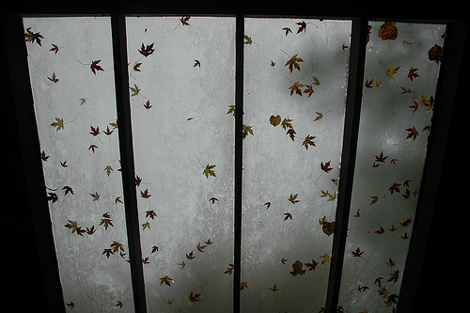
Leaves Fall, from "100 Ways..." ©Kate MacDonnell
LL: You are still continuing on with “100 Ways”. Are you working on any other series?
KM: The 100 ways work is morphing into something more ethereal. They’ll need more space. I’ll be printing them larger. The working title is either “Elements” or “What We Got.” And I have started to photograph on Florida Avenue in DC, the hand-painted address signage. That is just starting to take shape. Florida used to be Boundary Street. That was it. That was DC. So, I am photographing the old edge of the city -like in European towns that have the concentric walls of the expanding outer edge of the city. I like the layering that happens over the course of time as well as recording a moment in the history of the evolution of the city. This collection of intimate indicators of place are in that same vein of celebrating DC’s unique look as Ken Ashton‘s DC Theaters and his DC neighborhoods projects as well as Lely Constantinople‘s Georgia Avenue project. So, the work will be in good company.

Fireworks ©Kate MacDonnell
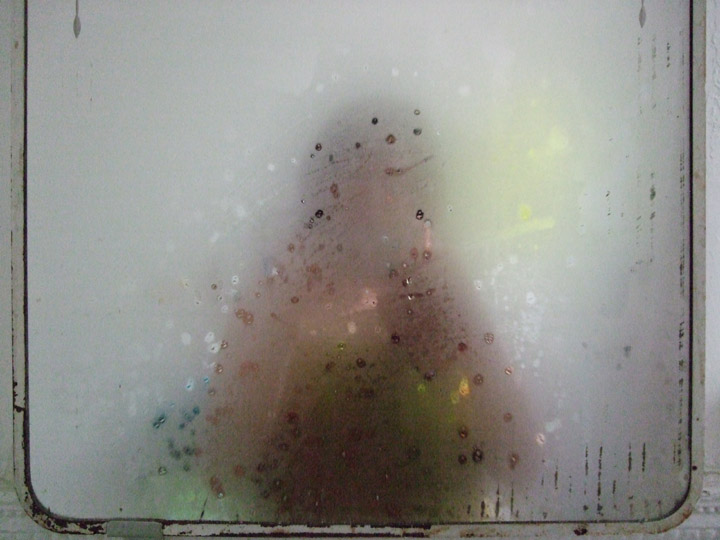
Looking for Constellations ©Kate MacDonnell

Snow ©Kate MacDonnell
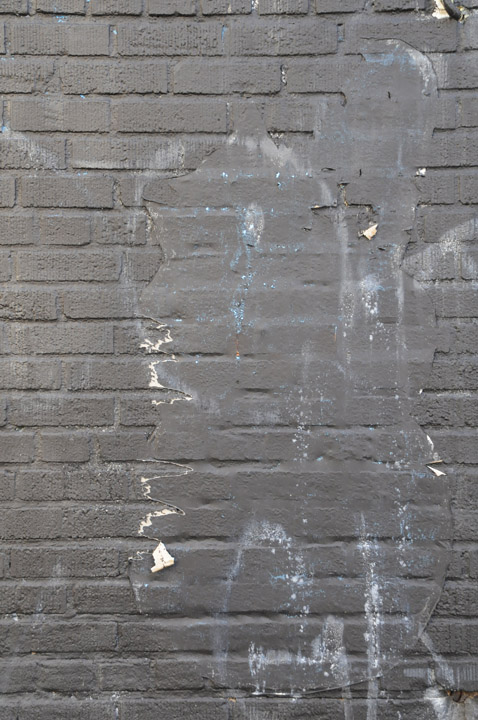
Painted over peep street art ©Kate MacDonnell
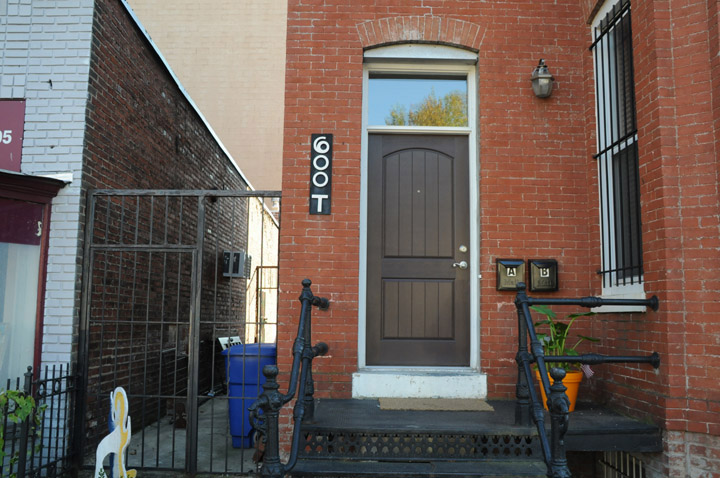
600 T Street ©Kate MacDonnell
LL: Thank you Kate.
Kate MacDonnell is represented by Civilian Art Projects (DC). Read an interview (2008) with director Jayme McLellan.
MacDonnell’s Blurb book can be viewed here.
MacDonnell’s work is part of “Empty Time” curated by Trevor Young at the Fridge (DC). Opening February 6, 8-11PM.
This interview was also published in a shorter form in ArtVoices Magazine, January 2010.

 w until March 20, 2010.
w until March 20, 2010.






 and the paper quality have improved, but at the time the quality of the paper and printing didn’t warrant the price of production. But, yeah, I love photo books as a medium. It is such a nice intimate way to view a collection of images. I would love to have a nicely published short-run trade edition eventually.
and the paper quality have improved, but at the time the quality of the paper and printing didn’t warrant the price of production. But, yeah, I love photo books as a medium. It is such a nice intimate way to view a collection of images. I would love to have a nicely published short-run trade edition eventually.






